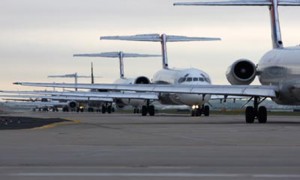Sunlight worsens jet pollution
Chemical reactions caused by the sun’s rays worsen air pollution from idling jets at airports
Share this:
- Share via email (Opens in new window) Email
- Click to share on Facebook (Opens in new window) Facebook
- Click to share on X (Opens in new window) X
- Click to share on Pinterest (Opens in new window) Pinterest
- Click to share on Reddit (Opens in new window) Reddit
- Share to Google Classroom (Opens in new window) Google Classroom
- Click to print (Opens in new window) Print

In the United States, nearly 50,000 planes fly every day. They open their doors, start their engines and wait. People board, fasten their seatbelts and wait. The planes close their doors, taxi to the runway and wait. All that waiting adds up to a lot of pollution produced by the powerful jet engines as they run at low power without moving, something engineers refer to as idling.
“If you’re number 46 in line awaiting takeoff, you could spend an hour idling,” Allen Robinson told Science News. Robinson is a mechanical engineer at Carnegie Mellon University in Pittsburgh. He recently worked with other scientists on an experiment that measured the particles coming from idling jets.
In the new study, Robinson and his colleagues captured and measured that pollution, then let it sit in the sun and measured it again. When the sunlight struck the tiny molecules produced by the engines, it caused a chemical reaction. That reaction altered the pollution, making it potentially more harmful than when it was first spit out. After several hours in the sun, the mass of pollution particles had multiplied by 35, on average.
Those numbers “sort of blew our minds,” Robinson told Science News. The new measurement suggests that scientists may be seriously underestimating the pollution produced at airports.
Previous studies have measured the polluting particles and gases coming directly from a jet engine. The new study is the first to measure the sun’s impacts on jet pollution. Getting an accurate measurement of a jet’s pollution is “very important to be clear on how aircraft emissions impact local and regional air quality,” Richard Miake-Lye told Science News. Miake-Lye, who did not participate in the new study, works at Aerodyne Research in Billerica, Mass.
To capture and measure the pollution, Robinson and his colleagues used a giant, inflatable bag called a smog chamber. The smog chamber could hold 7 cubic meters, which is about the same volume as two large cars. The team filled the bag with emissions from the jet, collected from about three feet behind the engine.
Once the bags were filled, the scientists started the second part of the experiment. They either uncovered the bag, letting sunlight stream in, or turned on ultraviolet lights. (The sun delivers ultraviolet, or UV, radiation to Earth, so ultraviolet lights can be used as a sun substitute to produce the same results.)
The sunlight or UV light started a process called photooxidation. Photo refers to light and oxidation refers to oxygen. So photooxidation happens when light and oxygen mix. In this case, the sunlight and oxygen caused solid particles of pollution to form out of the jet’s emission of gases and microscopic liquid fuel droplets. The scientists found that photooxidation boosted the number of pollution particles created when the engines are idling — and also when they’re using even more power, like during takeoff.
The size of the newly created particles was so small that if you lined up a billion, they’d measure about three feet. That small size makes these particles especially easy to breathe in deeply, allowing them to deposit in the lungs or even to migrate into the brain. In both places, the particles can harm tissues.
Airports may be a more significant source of pollution — especially these invisible, supersmall particles — than was previously recognized. If that’s not bad enough, consider this: Airport emissions, in general, have been on the rise, Ronald Henry told Science News. Henry is an engineer at the University of Southern California in Los Angeles.
Even as cars and trucks produce less pollution, airports are going in the opposite, upward direction. Now coming from an airport near you: more pollution, and of a very bad variety. And it’s at its worst as you’re waiting, waiting, waiting for takeoff.
POWER WORDS (adapted from the New Oxford American Dictionary)
photooxidation A chemical process caused by light where oxygen combines with other molecules.
engineering The branch of science and technology concerned with the design, building and use of engines, machines and structures.
pollution The presence in or introduction into the environment of a substance or thing that has harmful or poisonous effects.
particle A small amount of matter.
mass The amount of matter that an object contains.







